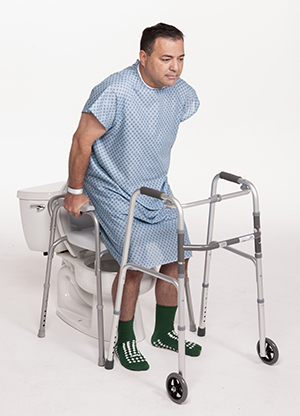Using the bathroom can be challenging after hip surgery. Follow your “hip precautions” and the tips on this sheet to keep your new hip safe when using the toilet.
-
Back up until you feel the toilet touch the back of your legs.
-
Place your operated leg in front of you, keeping your weight on the other leg.
-
Look behind you and grasp the grab bar (or side rails, if you’re using a toilet with rails).
-
Lower yourself onto the front of the toilet, then scoot back.
-
To get up, reverse these steps.
-
If you have a low toilet seat at home, your healthcare provider may prescribe an elevated toilet seat lift.
Remember your hip precautions
-
Don't bend your hip at the waist more than 90°. (Don’t move your knees and chest too far toward each other.)
-
Don't cross your legs or ankles or let your operated thigh cross the middle of your body.
-
Don't turn your operated hip or knee inward.


